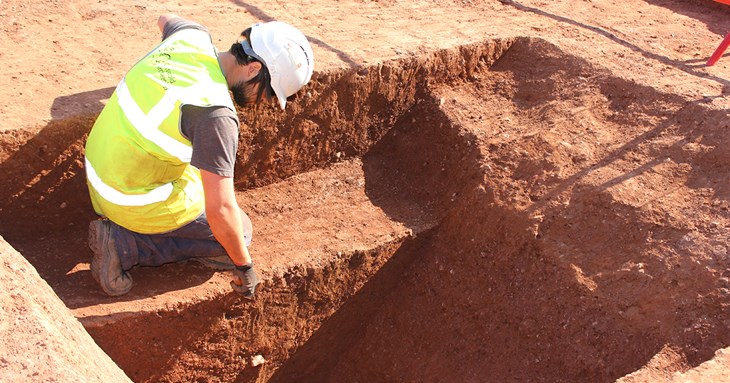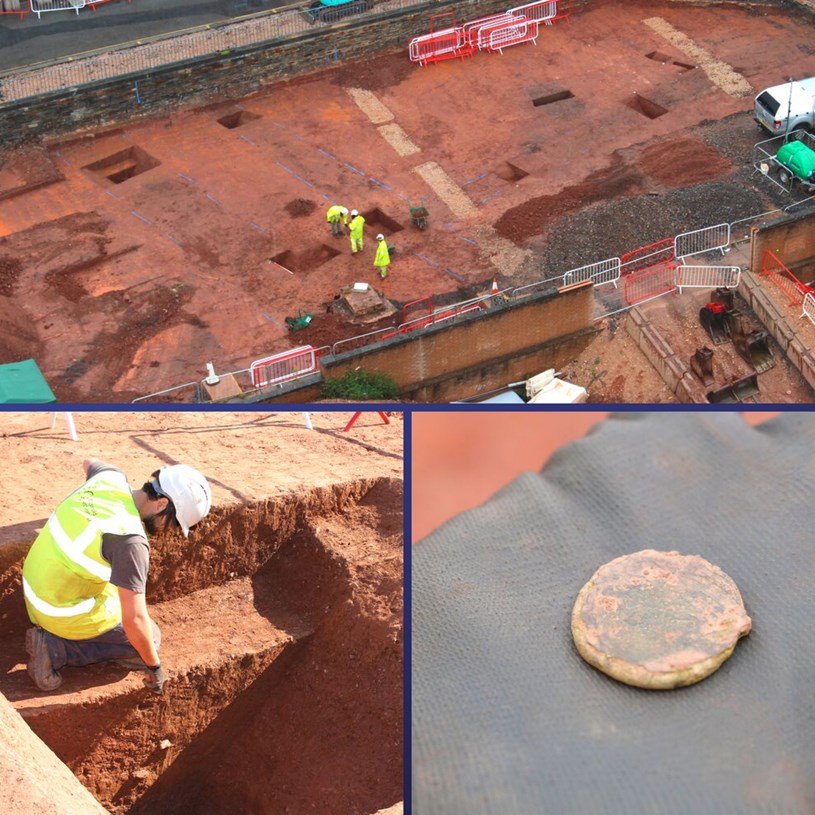Report into Roman Fort discovery highlights ‘important and fascinating’ find
Published: 18 August 2021

Archaeologists have completed a study into the remains of a Roman Fort discovered underneath the site of Exeter’s new bus station – and concluded that it was an “important and fascinating” find.
A new report into the findings from two years ago, concludes that what lies beneath Exeter continues to have the “capacity to surprise”.
The report is set to be published in the Devon Archaeological Proceedings Journal and will be made available to the public in the future.
Finds recovered from the Roman defences, including coins and local pottery made in the area, as well as fine red Samian tableware imported from France have been handed over to the Royal Albert Memorial Museum in Exeter.

At the time of the discovery, the find was described by an archaeology expert as “very important and completely unexpected.”
The surprise discovery was made by the Exeter Office of Cotswold Archaeology who were working with Kier Construction to record remains of the city’s Roman history ahead of the new bus station, which recently opened to the public.
First to be uncovered was a Roman ditch at the top end of the site between Bampfylde Street and Cheeke Street. Further excavations revealed two further large Roman ditches running parallel to each other.
Experts revealed that these belong to a new, and completely unknown, Roman military site, either a fort occupied by a military unit, or else an outer defence surrounding the Roman legionary fortress and its satellite depots and compounds.
Neil Holbrook, Chief Executive of Cotswold Archaeology said “The discoveries at St Sidwell’s Point once again demonstrate the important and fascinating potential of the archaeology of Roman Exeter, and its capacity to surprise. The archaeology associated with the presence of the Roman army in Exeter in the 1st century AD is internationally important and vividly demonstrates the importance of Exeter and the Exe estuary for the supply of the Roman army on campaign in the decades following the Roman invasion of Britain in AD 43.”
Both are typical Roman military ditches. The outer, eastern one has a steep V shaped profile, with a deep “ankle breaker” trench along the bottom. The inner, western one is larger and deeper, and would have been immediately in front of a rampart above it to the west. It has a much steeper, near vertical, outer side, which was designed to trap any attackers who got this far and to leave them at the mercy of the defenders on the rampart above. It also has a deep ankle breaker trench.
The inside of the fort, or depot or compound, was to the south-west of these ditches, under the rest of the bus station, and under Bampfylde Street and probably Sidwell Street. The other sides of it have yet to be discovered.
The City Council works closely with developers to ensure that any remains that are inevitably affected by new development are properly excavated and recorded for the benefit of this and future generations.
Background
In the years following their invasion in AD 43 the Romans pushed forward into the South West and elsewhere, and established a legionary fortress at Exeter in around AD 55. This was garrisoned by up to 5,500 men of the 2nd Augusta legion. At the same time a network of roads and smaller forts was established throughout Devon and Cornwall. In around AD 75 the army left the SW for South Wales, and the forts and fortress were demolished, and a civilian town established at Exeter as the regional capital. A century later the town was defended by a city wall, which can still be seen today.
Following the discovery in the 1970s of the fortress and of its bathhouse under the Cathedral Green, more recent work undertaken by archaeologists working for developers has uncovered major new discoveries around the city, including a large and important building on Mount Dinham, in St David’s, another fort under Princesshay and Southernhay, a large defended military depot on the former St Loyes College site on Topsham Road, a small fort and other military type buildings at Topsham, and now another fort or defended compound in St Sidwells.
Investigations on the site of the new bus station and leisure centre have confirmed that any remains that were present were destroyed over most of the site by the construction of the present bus station back in the early 1960s, when there was no planning requirement for developers to record remains.
